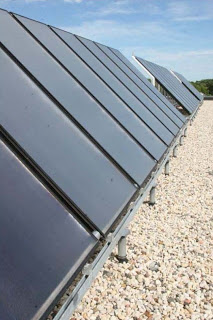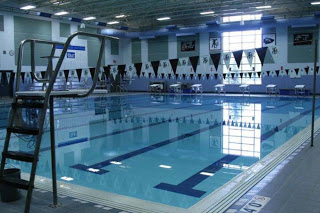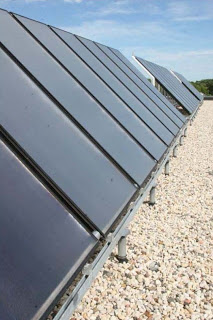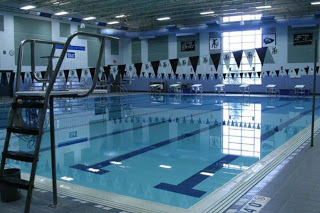by jboullion | Dec 8, 2009 | Uncategorized
From a news release issued by the Lawrence Berkeley National Laboratory:
Home sales prices are very sensitive to the overall quality of the scenic vista from a property, but a view of a wind energy facility does not demonstrably impact sales prices.Over 30,000 megawatts of wind energy capacity are installed across the United States and an increasing number of communities are considering new wind power facilities. Given these developments, there is an urgent need to empirically investigate typical community concerns about wind energy and thereby provide stakeholders involved in the wind project siting process a common base of knowledge. A major new report released today by the U.S. Department of Energy’s (DOE) Lawrence Berkeley National Laboratory evaluates one of those concerns, and finds that proximity to wind energy facilities does not have a pervasive or widespread adverse effect on the property values of nearby homes.
The new report, funded by the DOE, is based on site visits, data collection, and analysis of almost 7,500 single-family home sales, making it the most comprehensive and data-rich analysis to date on the potential impact of U.S. wind projects on residential property values.
“Neither the view of wind energy facilities nor the distance of the home to those facilities was found to have any consistent, measurable, and significant effect on the selling prices of nearby homes,” says report author Ben Hoen, a consultant to Berkeley Lab. “No matter how we looked at the data, the same result kept coming back – no evidence of widespread impacts.”
An expert witness on real estate voiced the same conclusion during hearings on We Energies proposed Glacier Hills Wind Park.
by jboullion | Dec 8, 2009 | Uncategorized
From a post on the Fixer-Upper Blog:
With the winter season upon us, the high heating expenses are not far behind. There was a time when the only to combat them was to stay away from the heater and suffer. However, in recent times there have been loads of advances in conservation, efficiency, and technology. Below are 8 painless ways to cut your electric bill that require a little time, less money, and can end up saving you hundreds, or perhaps thousands, of dollars across a short span of time.
1.Strip : According to the experts at Lowe’s, a 1/8″ space between a standard exterior door and its threshold is equivalent to a two square inch hole in the wall. Closing those gaps can save you up to 15% in heating costs and reduce the demand on your heating system. They also offer a guide on how to accomplish this at the beginner level. Only three tools, three materials, and a day is all it requires to weatherstrip your entire home.
2.Dodge The Draft : Cold air can seep in through your front, rear, or any entryway door. One of the best ways to deal with this is to install a draft dodger. As Seen On TV sells one for a considerable price. However, Green Upgrader shows you how to make one of your own at a fraction of the cost. All you need is some fabric and sewing supplies.
3.Find An Outlet : Another way drafts go in and out of the home is through the outlet and outlet covers, particularly the ones along exterior walls. Not to worry, there are special outlet and switch gaskets specially made to significantly reduce drafts. This store sells an entire kit for only $1.94.
4.Insulate : Water needs to be heated in the winter as well, so don’t throw money away by not insulating. If your water heater’s storage tank has a R-value of under R-24, adding insulation can reduce heat loss by 25-45%. The U.S. Department of Energy has tips on how to insulate both electric and gas heated water tanks. There are also other useful related guides.
5.Go Tankless : If you’re in the market for a new water heater, try a tankless one. They create hot water on demand so there’s no stored water needing to be continuously heated. They cost about $200 more than a standard water heater. However, the money you save by cutting your electric bills, especially in winter, can add up to that difference in just a few years. In addition, certain tankless heaters can qualify for up to a $1,500 tax credit.
6.Reflect On It : Radiator reflectors are insulation boards with aluminum or material on one side. When placed on the wall behind the radiator unit, they reflect heat back into the room, instead of allowing the heat to escape. An easy install for anyone looking to cut bills. They are also an inexpensive purchase at a hardware store, or you can make your own.
7.Program the Problems Away : A programmable thermostat allows you to set different temperatures for different times of the day, and even different times on different days. Cut your winter electric bills by setting it to automatically lower the temperature when you leave for work and raise it an hour before you return home. The DIY network shows you how to choose one and install it yourself, all in less than two hours.
8.Watch Out For Carbon Monoxide : The leading cause of poisoning accidents in the United States, a common cause of it is poorly maintained heating systems. Also, since the symptoms seem like the flu, it is not taken seriously. This video from WebMD show you how to prevent and detect it. Don’t waste the money you saved on winter electric bills with costly medical ones.
by jboullion | Dec 8, 2009 | Uncategorized
From an announcement published in the Stevens Point Journal:
A more proactive approach to the pending challenges of energy depletion and climate change will be the focus of a movie and panel discussion at the University of Wisconsin-Stevens Point.
The program will be held Thursday, Dec. 10, at 6:30 p.m. in the Dreyfus University Center Theater. Sponsored by the Students for Sustainable Communities, the event is open and free to the public.
The film, “The Great Squeeze,” discusses modern society’s over consumption of resources and the implications for the future of humankind and the Earth as a whole. Eric Olson, instructor and land use specialist in the College of Natural Resources, and Samantha Kaplan, assistant professor of geography, will lead the panel discussion and share their vision of a sustainable future.
by jboullion | Dec 7, 2009 | Uncategorized


Governor Jim Doyle signals a crane operator to lift the first pallet of solar panels (left) for installation on the West Wing of the State Capitol. Madison Gas and Electric (MGE) President Gary (middle) and Chris Collins (right), a representative of the installer H&H Solar, joined in the liftoff.
The 48 solar panels in the final installation will cover 9,600 square feet on the Capitol roof and produce about 11,700 kilowatt hours of electricity a year, slightly more than a typical Wisconsin home would use annually.The system will be owned and maintained by MGE, which is fully funding the $78,000 project.

by jboullion | Dec 7, 2009 | Uncategorized


The solar water heating systems serve Fort Atkinson high school and the middle school. The radiant energy striking the rooftop panels year-round is efficiently collected and taken inside to preheat the swimming pools inside each structure. Except during the winter months, the incoming solar energy is sufficient to maintain pool temperatures at 84°F. Even in January, however, the savings that a solar hot water system yields simply by preheating a pool to 70°F is substantial when multiplied over several decades.
As a result of educating themselves on the connection between energy use and atmospheric pollution, several school districts in Wisconsin are taking increasingly aggressive steps to conserve energy as well as produce a portion of what they use on-site. Some have embraced ground source heat pump systems (Fond du Lac High School), while others have installed solar hot water systems (Osceola Middle School) and solar electric systems (Paul Olson elementary school in Madison). Not to be outdone, Wausau East High School recently installed a 100 kW Northwind turbine, which is now the largest wind generator attached to a school building in Wisconsin.
Yet if one measures success by substantial reductions in energy expenditures and emissions reductions, there is one school district in Wisconsin that stands head and shoulders above its peers: Fort Atkinson. Serving 2,700 school-age children in a community of 12,000, the Fort Atkinson School District operates six buildings: four elementary schools, one middle school and a high school. School officials have made no secret of their aspiration to make Fort Atkinson the most energy-efficient and self-sufficient K-12 district in the state.
Since 2005, Fort Atkinson has rigorously pursued a sustainable energy agenda that integrates, in a systematic and complementary fashion, continuous monitoring of consumption, aggressive building efficiency measures, and renewable energy capture. As articulated in its 2009 energy plan, the district, the district’s principal goals for 2010 are nothing if not ambitious:
+ Pare energy costs by 20% from 2005 levels;
+ Lower carbon emissions by 25% from 2005 levels;
+ Obtain EnergyStar certification for all six schools; and
+ Install on-site renewable production at all six schools.
Virtually every renewable energy technology or efficiency measure available to a Wisconsin K-12 district has already been or is about to be deployed somewhere in Fort Atkinson. This lengthy list includes ground source heat pumps, solar hot water systems, lighting retrofits, tankless water heaters, retro-commissioning, occupancy sensors, window replacement, and roof insulation. The most recent system to be installed, a 50 kilowatt wind turbine at the high school, will be operational by Christmas 2009.
The integrated approach pursued by Fort Atkinson leads to lower operating expenses, which in turn frees up capital for renewable technologies that have higher up-front costs but will deliver energy to the school buildings long after the initial investment is paid off. At the same time, converting sunlight and wind into useful energy sources enable building owners to reduce the variability of their utility costs. For a school district, that means not having to worry about the effect of a colder-than-normal winter on next year’s budget for textbooks.
The solar water heating systems serving the high school and the middle school neatly illustrate this benefit. The radiant energy striking the rooftop panels year-round is efficiently collected and taken inside to preheat the swimming pools inside each structure. Except during the winter months, the incoming solar energy is sufficient to maintain pool temperatures at 84°F. Even in January, however, the savings that a solar hot water system yields simply by preheating a pool to 70°F is substantial when multiplied over several decades.
The capital required to heat a swimming pool with solar energy is not trivial. For the 48-panel system atop the high school, the installed cost totaled $198,000, while the 32-panel installation serving the middle school came in at $115,000. Dennis Kuchenmeister, who manages the district’s buildings and grounds, estimates a 5% return on investment (ROI) for the high school’s system and an 11% ROI on the middle school’s system. According to Kuchenmeister, the hot water systems will supply about 60% of the heat going into the pools, displacing the equivalent of nearly 9,000 therms a year. The district expects to save $18,000 in avoided fuel costs per year.
Kuchenmeister’s economic estimates factor in incentives from Focus on Energy covering up to 35% of the total installed cost and matching incentives from We Energies, the local utility serving the school district. By taking full advantage of available incentive dollars, the school district was able to reduce the out-of-pocket portion of installation costs by more than 50%.
Because the annual harvest of solar energy striking a particular spot rarely fluctuates by more than 10%, a building owner can be reasonably confident of how much conventional energy an installation will displace. In contrast, the cost of heating a pool with natural gas can easily triple during a 12-month period even when usage remains constant. This in fact happened to Fort Atkinson in the 12 months preceding the installation of its two solar hot water systems in the fall of 2008.
Thus, the real value of Fort Atkinson’s solar hot water installations is in minimizing the district’s exposure to the price volatility associated with unregulated fossil fuels like natural gas. And while it’s true that natural gas prices are presently at five-year lows, they could easily bounce back to 2008 levels in a year or two, depending on events over which end-users have no control. However, by installing a renewable technology that preheats their swimming pools, the Fort Atkinson has effectively insured itself against a repeat appearance of the fossil fuel rollercoaster ride that most school districts would just as soon forget.
There are two other reasons why school buildings are well-matched for solar energy installations. First, the buildings themselves are dedicated to a public function that is expected to last for several generations. In such settings it is easier to justify the additional up-fronts costs, especially if the installation also communicates a valuable lesson in sustainability to the entire community. Second, most schools, especially newer ones, have an abundance of flat, unshaded roof space that can support large arrays, irrespective of building orientation.
Real-time production data from both installations can be accessed online by visiting www.fatspaniel.net and searching for the live sites listed under We Energies. The district also uses Energy Watchdog, a web-based program provided by Focus on Energy to track energy usage. This program enables Fort Atkinson to document the energy and cost reductions from measures specified in its energy plan.
The middle school is also one of four schools in Fort Atkinson equipped with ground source heat pump systems that heat and cool the buildings year-round using the nearly constant temperatures in the ground. These systems heat buildings in the winter and cool them in the summer. Ground source heat pump systems are electrically powered; no heating fuel like natural gas or propane is needed to heat the four schools.
“We essentially cut the gas line to our schools,” said Kuchenmeister during a presentation on his district’s sustainable energy initiative last November in Milwaukee.
The operational costs of ground source heat pumps are substantially lower than the HVAC systems they replace. As a result of their renovation, the three elementary schools have seen their energy intensity drop by more than one-half, even though they now have air-conditioning in the classrooms. School officials estimate that all four ground source heat pump systems will save the district $30,000 annually in fuel costs.
As with solar hot water systems, Focus on Energy provides incentives for ground source heat pumps to schools, businesses and residences. The program awarded more than $96,000 towards the four systems installed in Fort Atkinson.
According to a Focus on Energy fact sheet, “a ground source heat pump system is arguably the most efficient technology for heating and cooling Wisconsin homes and businesses.” Given its embrace of that technology and others deployed in its buildings, Fort Atkinson has become, in terms of energy sustainability, arguably the most forward-thinking school district in the state.

by jboullion | Dec 7, 2009 | Uncategorized


The solar water heating systems serve Fort Atkinson high school and the middle school. The radiant energy striking the rooftop panels year-round is efficiently collected and taken inside to preheat the swimming pools inside each structure. Except during the winter months, the incoming solar energy is sufficient to maintain pool temperatures at 84°F. Even in January, however, the savings that a solar hot water system yields simply by preheating a pool to 70°F is substantial when multiplied over several decades.
From a story by Michael Vickerman, RENEW’s executive director:
As a result of educating themselves on the connection between energy use and atmospheric pollution, several school districts in Wisconsin are taking increasingly aggressive steps to conserve energy as well as produce a portion of what they use on-site. Some have embraced ground source heat pump systems (Fond du Lac High School), while others have installed solar hot water systems (Osceola Middle School) and solar electric systems (Paul Olson elementary school in Madison). Not to be outdone, Wausau East High School recently installed a 100 kW Northwind turbine, which is now the largest wind generator attached to a school building in Wisconsin.
Yet if one measures success by substantial reductions in energy expenditures and emissions reductions, there is one school district in Wisconsin that stands head and shoulders above its peers: Fort Atkinson. Serving 2,700 school-age children in a community of 12,000, the Fort Atkinson School District operates six buildings: four elementary schools, one middle school and a high school. School officials have made no secret of their aspiration to make Fort Atkinson the most energy-efficient and self-sufficient K-12 district in the state.
Since 2005, Fort Atkinson has rigorously pursued a sustainable energy agenda that integrates, in a systematic and complementary fashion, continuous monitoring of consumption, aggressive building efficiency measures, and renewable energy capture. As articulated in its 2009 energy plan, the district, the district’s principal goals for 2010 are nothing if not ambitious:
+ Pare energy costs by 20% from 2005 levels;
+ Lower carbon emissions by 25% from 2005 levels;
+ Obtain EnergyStar certification for all six schools; and
+ Install on-site renewable production at all six schools.






